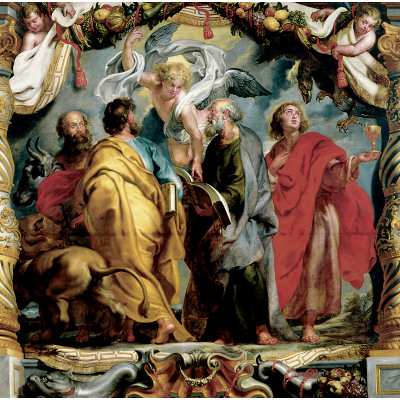His mastery of color along with his knowledge of antiquity is seen particularly in his mythological paintings. As court painter and confidant to the Archduchess Isabella Clara Eugenia, Rubens recognized the role art was to play in the Counter Reformation. His genius found expression in his designs for the Triumph of the Eucharist tapestries which he and his assistants completed between 1625 and 1628. Knighted by two monarchs and master of a successful workshop, Rubens became rich and famous in his own time. Having executed over 3,000 paintings, woodcuts and engravings of all types, he died the most respected artist of his time in 1640. Subject: The man represents Matthew because it is his gospel that begins with the tree of the ancestors of Christ. Mark opens with the voice crying in the wilderness, an allusion to the lion. The Ox, the sacrificial beast, is Luke whose gospel begins with the account of the sacrifice of Zacharias. The eagle, of all birds the one that flies nearest to heaven, represents John whose vision of God was closest and distinct from the others. Painting: The concept of Divine Inspiration is given center stage with the Angel of St. Matthew gesturing toward heaven and pointing to the book that he holds. The Eagle of St. John swoops down from the fly space above the poscenium to our right, while the Bull of St Luke and St. Mark's Lion exit off stage to our left. The dolphin, shell and cornucopia that decorate the face of the stage apron are symbolic of the widespread influence of the Four Evangelists across the earth and the seas. Historical Context: The series is a mixture of allegory and religious propaganda intended to promote the worship of the Eucharist (ie the bread and wine consecrated as the body and blood of Christ and distributed at communion) which had been strengthened recently by the Council of Trent and which constituted an important element in Counter Reformation Catholicism. This was a time of great concern on the part of the Catholic church as it attempted to correct not only the abuses of the clergy but also to reaffirm its tenets / dogma in the face of attacks by the Protestant Reformation.
|
